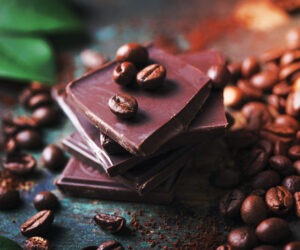Brewing with Dark Sugars

Brewers often have an antipathy to adding sugar to their brews, even though such additions have been common in commercial brewing for over a hundred years. Invert sugar (sucrose inverted by chemical hydrolysis to glucose and fructose) has been widely used in British brewing sometimes as a brew extender to permit producing a greater volume of beer than would normally be possible with a given size of mash tun and kettle. More often its use as a “nitrogen diluent” has been heavily promoted; one purpose of sugar addition is that for the same original gravity (OG) it reduces the amount of protein material in the beer and prevents or limits chill hazes.
In the US, sugar (usually derived from corn) has been widely used for the same purpose, in particular because it permitted the use of malts from 6-row barley, which is generally higher in protein content than that from 2-row barley. And if you think that this applies only to modern beers, and not to that good old stuff they brewed prior to Prohibition, think again. I am lucky enough to have in my hands early 19th century brewing books from a Connecticut brewer, in which all of the ales used both sugar and flaked corn as adjuncts.
Nowadays, home and craft brewers generally think in terms of beers produced solely from malt, with the use of any kind of adjunct being frowned upon. Cane or corn sugars may be used in limited amounts to increase the alcohol level of a beer, or to “dry out” a beer. By that I mean that because these sugars are fully fermentable the beer will have a lower finishing gravity and will be a little drier on the palate than would otherwise be the case. A classic example of this is the brewing of Belgian dubbel and trippel ales (in this instance the brewers use candi sugar, which is a very pure form of sugar from beets), although it also comes in colored, lightly caramelized forms that can also add color and flavor to the beer. Other sugars are also permissible when added purely for flavoring purposes, notably honey and maple syrup. In one style (milk or cream stout) the use of lactose, a sugar that is not fermented by brewing yeasts, is mandated. Here the lactose gives a full, luscious flavor to a beer low in alcohol relative to its original gravity. Then, of course, there are various types of brown sugars, which are relatively unrefined and mainly get their color from the presence of some molasses in them, so they can add flavor to a beer.
I have seen many references in the brewing literature to the effect that brown sugars can be used for flavoring purposes in brewing, but rarely have I seen a recipe where such sugars are used. So the purpose of this article is to give such a recipe, and the sugar in question is muscovado, perhaps the darkest of such crude sugars. Molasses, of course, is the crudest product from sugar cane, and is only partly fermentable, containing about 50% sugar. It is very strongly flavored and nowadays is generally regarded as unsuitable for brewing purposes, although it was widely used in this country in the 17th and 18th centuries when it would have been cheaper and more readily available than barley malt. Indeed, none other than George Washington left behind a recipe for beer that incorporated molasses.
Muscovado is made by heating the raw juice from sugar cane until it has been sufficiently concentrated by evaporation to begin the sugar crystallization process. The crystals are separated from the cooled mixture by various methods, all of which basically drain off the other liquor (molasses) from the dark brown muscovado crystals. My research indicates that this sugar is made commercially in only two places, Mauritius and the Philippines. It is, however, available in this country, although I haven’t seen it in homebrew supply stores I have checked. However, Amazon offers muscovado from several suppliers, including the British company from whom I bought my sample. None of these were cheap, the prices varying around $7–8 per pound.
Why did I opt for muscovado? Well, partly for historical reasons, since it is about as close to molasses as you can get and yet is still mostly sugar, so it might cast a little light on how those early colonial beers tasted. But, more importantly, I used it because I had picked up some on a whim while on a trip to Britain and decided to make a brew with it just to see how it would turn out. I also felt that as a low-refined sugar it would offer more flavor to the beer than lighter sugars, such as Demerara sugar (which is actually refined sugar with a small proportion of added molasses). Of course, there was a risk in this that if the molasses flavor were too strong it would dominate the beer, so I had to formulate the recipe carefully in order to minimize this potential problem. Besides, this was to be an experiment so there had to be some risk, didn’t there?
Formulating the recipe
First and foremost I was not going to make a beer to fit any style guidelines, but merely one that would show off the effect of the sugar. Something dark seemed to fit the bill, and I had in the back of my mind brews like Theakston’s Old Peculier, a beer based on an ancient recipe, or Manchester Star, a beer brewed from an 1884 recipe by J.W. Lees in consultation with Garrett Oliver of Brooklyn Brewery, or even just a strong dark mild. Anyway, it was not going to be any kind of clone, but rather a beer that would stand on its own hind legs.
I decided I wanted a beer of fairly high OG so there would a reasonable amount of alcohol to help balance any residual sweetness from the sugar. I thought 1.065–1.067 (15.9–17.1 °P) would be about right, but before deciding on a malt bill, I had to allow for the sugar addition. I reasoned that sucrose gives a gravity of 1.046/lb./gallon or about 9 gravity points for 1 lb. in 5 gallons (19 L), so my 1.1 lb. (500 g) muscovado would add about 10 points in 5 gallons (19 L). So the malts would have to give a total specific gravity (SG) of 1.055–1.060. Note that this does not mean that muscovado is totally fermentable as is sucrose. In case the muscovado had significant moisture content I did check the gravity of the wort both before and after the sugar addition and the increase was indeed 10 gravity points.
For the malts, I wanted to use as a base about a 2:1 mixture of 2-row pale and 8 °L Munich malt, using the latter to give a little bit more body than if I used pale malt alone. And I wanted this mixture to make up about 70% of the total grain bill to allow for the other malts, starting with a little less than 10% each of Vienna and Victory® malts, to add some nutty and biscuit flavors. Then about 5% caramel 60 °L malt to add some caramel sweetness and palate fullness, followed by about 2% of Briess Blackprinz® de-bittered black malt to give a hint of roast character without harshness. And finally, I slipped in about 4% of Briess Carabrown® malt to add some licorice note in the background. I also opted for a relatively high mash temperature of 152–154 °F (67-68 °C) to make sure the beer did not finish too dry on the palate.
My choice of hops was to go for bittering only, and at a modest level of about 30 IBU with East Kent Goldings. This is a beer that is definitely not all about the hops! And lastly, I chose to use a London ESB yeast as this gives a slight fruitiness, a medium level of attenuation, and flocculates well. So, after all that folderol here is the recipe, which I simply called Dark Planet with no reference to any style:
Dark Planet
(5 gallons/19 L, all-grain)
OG = 1.067 FG = 1.016
IBU = 31 SRM = 40* ABV = 7%
*This is the malt contribution only, the actual color will be darker due to the sugar
Ingredients
6.5 lbs. (2.95 kg) 2-row pale malt
3 lbs. (1.4 kg) Munich malt (8 °L)
1 lb. (0.45 kg) Vienna malt
1 lb. (0.45 kg) Briess Victory® malt (28 °L)
0.5 lb. (0.23 kg) caramel malt (60 °L)
0.25 lb. (0.11 kg) Briess Blackprinz® malt (500 °L)
0.5 lb. (0.23 kg) Briess Carabrown® malt (55 °L)
1.1 lb. (0.5 kg) muscovado sugar (0 min.)
8.1 AAU East Kent Goldings hops (90 min.) (1.1 oz./32 g at 7.2% alpha acids)
Wyeast 1968 (London ESB), White Labs WLP002 (English Ale) or Lallemand Windsor yeast
2⁄3 cup corn sugar (if priming)
Step by Step
Mash the grains at 152–154 °F (67–68 °C) with 14 qts. (13 L) water and let rest one hour. Run off and sparge with hot water at 160–170 °F (71–77 °C) to collect around 6 gallons (23 L) of wort. Boil for 90 minutes, with hops added at start. When done, turn off heat and add sugar, stirring well to make sure it is properly dissolved (be careful when stirring wort this hot). Rack from trub, cool to 65–70 °F (18–21 °C) and pitch yeast; ferment at same temperature for 5–7 days before racking to secondary. Leave it in the secondary for 1–3 weeks before bottling or kegging.
Extract version
I can’t give you a tested recipe since I haven’t tried to make this beer with malt extract. I would suggest eliminating the brown malt and Vienna malt and simply steeping the other grains. You can get extracts made from a 50:50 mix of pale and Munich malts, and this will work well here.
Dark Asteroid
(5 gallons/19 L, extract with grains)
OG = 1.067 FG = 1.016
IBU = 31 SRM = 40* ABV = 7%
*This is the malt contribution only, the actual color will be darker due to the sugar
Ingredients
6 lbs. (2.7 kg) Munich liquid malt extract
0.8 lb. (0.36 kg.) dried malt extract
1 lb. (0.45 kg.) Briess Victory® malt (28 °L)
0.5 lb. (0.23 kg) caramel malt (60 °L)
0.25 lb. (0.11 kg) Briess Blackprinz® malt (500 °L)
1.1 lb. (0.5 kg) muscovado sugar (0 min.)
8 AAU East Kent Goldings hops (90 mins) (1.1 oz./32 g at 7.2% alpha acids)
Wyeast 1968 (London ESB), White Labs WLP002 (English Ale) or Lallemand Windsor yeast
2⁄3 cup corn sugar (if priming)
Step by Step
Place all the milled grains in a muslin bag, add to 2 gallons (7.6 L) of water at 165 °F (74 °C), and keep at 150–155 °F (66–68 °C) for 30 minutes to 1 hour. Remove the bag, rinse with hot water, and combine this water with that from the partial mash. Stir in the malt extract and bring to a boil. Add hops and boil 90 minutes. The remainder of this recipe procedure is the same as the all-grain version.
How does it taste?
Dark Planet is dark brown in color, almost opaque in a pint glass. It is a full-bodied, chewy, satisfying brew. It is not too sweet, and has just enough bitterness to be noticeable but not to intrude. There’s also a nice hint of licorice from the brown malt (as intended!), but it does not taste of molasses as such. Overall it is a very well-balanced beer, and one that I shall brew again.



